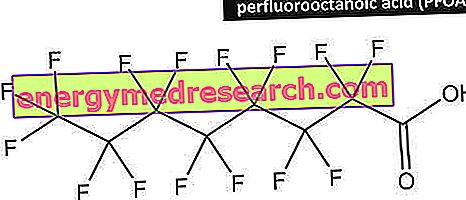What are PFAS?
PFAS is the acronym of " perfluoroalkyl substances ". These are chemical compounds belonging to the surfactant category and used since 1950 in a wide range of industrial applications and more. For example, PFAS is required for:
- Body care products
- Fire-fighting foams
- Waterproof, make various objects such as:
- Food containers and packaging, eg plastic boxes, waxed paper, etc.
- Pans, eg non-stick pans etc.
- Coatings of objects, eg carpets, seats, sofas etc.
- Clothing, eg leather, Gore-Tex® etc.
Some examples of PFAS are:
- Perfluorooctanoic acid (PFOA)
- Perfluorooctane sulfonic acid (PFOS)
- Perfluoroexane sulfonic acid (PFHxS)
- Perfluorononanoic acid (PFNA)
- Perfluorodecanoic acid (PFDA).

PFAS in Veneto
Why is it important to know PFAS? The Venetian question
PFAS pollution in the Veneto region
PFAS is currently the subject of strong controversy.
Classified as ubiquitous environmental pollutants, perfluoroalkyl substances are present (even in small quantities) in the soil, water and food (vegetables and animals) of the entire planet. On the other hand, their concentration increases greatly in civilized areas and exponentially near the places where PFAS are (or were) produced / processed. From the discharges of the plants in question, the perfluoroalkyl substances are in fact able to contaminate the aquifers used for drinking water, to irrigate the fields and to water the animals on farms.
In a particular area of the Veneto region (in particular the area between the provinces of Vicenza, Verona and Padua) the population shows a high and abnormal rate of PFAS in the blood. This anomaly is mainly due to the activity of a local company that seems to have discharged large quantities of perfluoroalkyl substances into the environment, making the water NOT drinkable, despite the purification of the operating aqueducts; this in spite of the fact that the environmental PFAS limits imposed by the Italian legislation are decidedly higher than in the United States, Germany etc.
Objective data on the presence of PFAS in the residents' organization
Unfortunately, the human organism is not able to metabolize and eliminate PFAS effectively; on the contrary, as the current situation shows, it tends to accumulate instead.
Bioaccumulation is due to the fact that perfluoroalkyl substances bind to blood proteins and, with them, are recovered during renal filtration. The measurements made on the plasma of certain inhabitants of the "red zone" are apparently shocking; these are concentrations that sometimes exceed several hundred ng / l (values tens of times higher than the limit recognized as harmless to health).
Beyond the fact that no citizen would like to be exposed in a decisive manner to PFAS (or other pollutants), there is a worrying possibility that these could negatively affect the general health status and increase the risk of death. Many are hypothesizing that the excess of perfluoroalkyl substances promotes hypercholesterolemia, problems with the thyroid, liver, kidneys, testicular cancer, breast cancer, etc.
The institutions' response to the PFAS emergency
For these reasons the institutions, in fits and starts and also governed by uncertainty, with the usual aptitude for the "discharge barrel", are proposing some solutions to protect the health of the residents.
It is curious to note that, despite the request was made well in advance, the analyzes on the concentrations of perfluoroalkyl substances in food (from local agriculture and breeding) have suffered a certain delay. Furthermore, while it was initially decided to intervene by completely suspending the use of local water, today it is proposed to install additional filters for activated carbon. Moreover, it must also be emphasized that the application of the so-called plasmapheresis (washing of the blood plasma) to remove the PFAS), suggested by the competent bodies, is completely experimental, ie it does not provide any guarantee of effectiveness.
In such a situation it is easy to panic; this is well known by the mass media and various TV, radio programs and websites are beginning to spread information in an incomplete or inappropriate manner. The purpose of this article is to clarify the subject by splitting the "true" from the "probable" and further from the "possible".
Environmental Hazard
Too many PFAS in the environment
Due to the massive industrial production (contamination of the discharges), agricultural implications (use of sludge for fertilization), transport accidents (discharge in port waters), atmospheric diffusion (always industrial) and disposal of the waste that contains them, in past there has been an increase in the environmental concentration of perfluoroalkyl substances. Like many other pollutants, PFAS also settle from the atmosphere to the ground, penetrate into the subsoil and, through the underground layers, reach the waterways. The water that comes out of our taps is obtained from the rivers through drinking water. It is therefore logical to deduce that perfluoroalkyl substances are present both in drinking water and in food (vegetables, meat, fruit, milk, eggs, fishery products, etc.).
Currently (especially in the last 4 years: 2013-2017), the competent bodies (ARPA, CNR, Legambiente etc.) are denouncing an increase in the rate of perfluoroalkyl substances (in the air, in the earth and in water), claiming that they can exercise a harmful effect on the health of the entire ecosystem and also of human beings. . The area most affected by this phenomenon, as anticipated in the previous chapter, is the Veneto region. However, more recent studies in the USA show that the levels of PFOS and PFOA in the general population are decreasing (3.07 and 9.32 μg / L on average for PFOA and PFOS, respectively), due to the interruption of their production and use.
What's more, PFAS have the characteristic of being highly resistant to degradation. They remain in the environment for a long time and therefore tend to accumulate, reaching potentially critical levels.
Health
PFAS and health: generalities
PFAS such as PFOS, PFOA and PFNA (see introduction) have attracted the attention of environmental and health regulatory agencies due to their persistence, hypothetical toxicity and spread in the blood of the general population and wildlife.
In 2009 the PFAS were cited as "persistent organic pollutants" under the Stockholm Convention due to their ubiquitous, persistent, bioaccumulative and toxic nature. Their production was therefore regulated or eliminated by many producers such as, for example 3M, DuPont, Daikin and Miteni, in the USA, Japan and Europe. Some have replaced them with less harmful equivalents (which we will mention later).
If, for various reasons, PFAS accumulate in the body, they could have a harmful effect on health; some even suspect a decisive role in the mechanism of carcinogenesis. Before jumping to hasty conclusions, however, it is essential to group all the available information on the "real" impact of perfluoroalkyl substances in the human body.
First of all, although it is always better to avoid that "foreign" compounds reach the inside of the body, we remember that it is "the dose to make the poison". Furthermore, PFAS are very many and even quite different from each other, which means that not everyone has the same impact on health. Moreover, it is not certain that these PFAS cause damage in their "normal" chemical-physical form. For example, the food-grade Teflon used to coat non-stick pans or to make kitchen cutting boards (polytetrafluoroethylene - PTFE, belonging to perfluorocarbons - PFC), becomes objectively harmful to health only when heated (or rather, burned) over 260 ° C.
However, there is no doubt that exposing oneself to very high concentrations of PFAS, caused by environmental pollution, tends to accumulate equally significant quantities within the organism; it is believed that the male body uses even more time (about 3 years) than the female one. As anticipated, perfluoroalkyl substances bind to plasma proteins and resist renal filtration which eliminates them with great difficulty. To halve the amount of PFAS in the blood, in the absence of exposure, respectively for women and for men, it is necessary:
- from 1.5 to 14.7 years for PFOA
- from 0.4 to 11.5 years for PFOS
- 24 to 46 days for PFBS
- 72 to 87 hours for PFBA.
PFAS on the human body: cholesterol and estrogen
Research on perfluoroalkyl substances and perfluorooctanoic acid (PFOA) offers rather mixed or inconclusive results. The experiments that have found negative effects on health are mainly those performed on research samples exposed for a long time and to relevant concentrations of these pollutants in the air; it is therefore the case of workers who work in certain industrial plants and who therefore tend to inhale volatile PFAS. In this case, there were some negative changes associated with the increase in perfluoroalkyl substances in the blood; in particular, a change in blood parameters related to cholesterol and estrogens was noted.
ULSS 8 Veneto Region Quote:
"The association repeatedly found in the various studies with a trend dependent on the dose of internal exposure (higher blood levels of PFOA and PFOS correspond to the more marked effect), is an increase in cholesterol levels in the blood and uric acid, and possible increased risk of hypertension.
The interpretation of the data is made even more difficult when the effects are so common in the general population and not very specific due to the presence of confounding factors (for example, cholesterol levels can be highly influenced by lifestyles) ".
PFAS: animal test
Animal tests have shown that PFAS can exercise
- Toxicity, ranging from acute to moderate, directly on the gastrointestinal system, liver and thyroid function, if ingested orally and / or chronicly at high concentrations
- Adverse effects on the skin on the eyes, due to exposure or contact to high concentrations of PFOA.
PFAS and Cancer
ULSS 8 Veneto Region Quote:
"Although some studies have suggested a possible correlation in subjects exposed to very high doses (eg production site workers) with testicular and renal tumors, due to observed inconsistencies, it was not possible to conclude definitively about the link between exposure to PFOA and PFOS and cancer in humans.
The same authors indicate that the effects found should be interpreted with caution, both because the study design often does not allow for establishing a causal link per se, and because the results are often at odds between studies (some of which are quality poor and have a lower weight in the evaluation) ".
PFAS and cancer in animals
ULSS 8 Veneto Region Quote:
"Although numerous studies are available on different species (in which the liver is the main target of toxicity), the extrapolation of these data to humans is particularly difficult due to the significant differences in the permanence of these substances within the organism ( much lower in rodents) and in the way in which they cause toxicity (some mechanisms related to the toxicity of PFAS in animals are not relevant for the human species). The results obtained with PFBA and PFBS indicate lower toxicity (about two orders of magnitude) compared to congeners with 8 carbon atoms ".
PFAS and cancer: conclusions
Currently available data seem to deny the hypothesis that environmental PFAS can cause cancer in humans. For the benefit of the doubt, further more detailed and in-depth information is awaited. On the contrary, an increase in tumor forms has been observed in animals exposed to high PFOA and PFAS concentrations.
However, all this is not sufficient to include perfluoroalkyl substances in the list of potentially carcinogenic substances; many other compounds, including certain nutritional factors, taken in "abnormal" concentrations can harm health or increase the chances of cancer.
On the other hand, since prudence is never too much, research institutes are continuing to test the effects of PFAS and PFOA on tumor development mechanisms. At the same time, companies are required to abolish these materials, favoring others that are less polluting or more easily metabolizable by the body.
children
Are PFAS dangerous for children?
PFAS on baby animals
An experiment carried out on animal exposure in pregnancy at very high concentrations of PFOA and PFOS revealed certain effects on the growth and / or birth defects of puppies; for this reason, specific investigations have been initiated with regard to the effects on humans.
PFAS on children
Some studies have been carried out on the effect of high concentrations of PFOA in the body of children. Although in the short term, no negative consequences on the child population have been established; missing long-term insights.
In pregnancy and lactation, although high levels of PFOA have been observed in the mothers' bodies, they have not been appreciated: prenatal complications, developmental defects, general health changes and increased PFOA levels in breast milk. A connection seemed to have emerged between high concentration of perfluorooctanoic acid and low birth weight; however, subsequent experiments have denied this hypothesis.
Conclusions
Danger PFAS: conclusions
It is legitimate and necessary that the competent bodies push to limit the spread of PFAS as much as possible, especially given the anomalous concentrations in the environment and in the organism in certain areas (see the Venetian question). For several years it has been suggested to replace, even partially, the perfluoroalkyl substances with alternative products; for example, new-generation fluorinated compounds and non-fluorinated surfactants. Furthermore, it would be desirable for the competent bodies to adopt containment and remediation measures for existing environmental damage as soon as possible, in order to preserve public health. On the other hand, even media outlets should do their part by trying not to support "alarmism" and instead to encourage correct information about it.
Bibliography
- Critical Public Health Manual - Francesco Calamo Specchia - page 283
- Company ULSS 17 - Veneto Region
- Agency for Toxic Substances and Disease Registry - US Department of Health and Human Services
- Health Protection Agency- Public Health England



